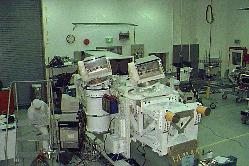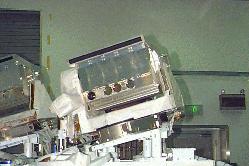GLO5 and GLO6 - STS-85
The two GLO instruments have been interfaced to
the IEH2 hitchhiker bridge for flight on STS-85,  August
7, 1997. The orbit will be inclined 57° with a launch window
causing the orbiter to pass through the earth shadow in the southern hemisphere.
There are several reasons for flying the two nearly identical GLO instruments
together. The most important are probably: 1) to allow
stereoscopic viewing of dayglow structures such as metal ion clouds and
gravity waves, 2) to try and relate waves observed in the night sky emissions
from orbit to orbit, and 3) we can maintain continuous surveillance of
the airglow throughout the flight with one instrument while the second
instrument is performing supporting experiments.
August
7, 1997. The orbit will be inclined 57° with a launch window
causing the orbiter to pass through the earth shadow in the southern hemisphere.
There are several reasons for flying the two nearly identical GLO instruments
together. The most important are probably: 1) to allow
stereoscopic viewing of dayglow structures such as metal ion clouds and
gravity waves, 2) to try and relate waves observed in the night sky emissions
from orbit to orbit, and 3) we can maintain continuous surveillance of
the airglow throughout the flight with one instrument while the second
instrument is performing supporting experiments.
STS-85 GLO5, GLO6 Instrument Enhancement
One of the important advantages of the Shuttle
as an observing platform is having time in space long enough to fully exercise
the experiment, followed by the opportunity to improve and develop new
techniques for the next flight opportunity. The following adjustments
have been made to the GLO instruments to adapt them to a developing scientific
program and improve the performance.
Scan Platform Orientation
Both of the GLO scan platforms have been placed
on a 15° wedge (see Figures). This will ensure continuous monitoring of the airglow emissions throughout the mission.
For a considerable time during a shuttle flight, the orbiter is in a bay
to earth attitude. The 15° wedge tilts the slit 15° to the
horizon instead of tangent as in the past. At 15° the slit extends
over 65 km in altitude at the limb, giving excellent data on both night
airglow and day glow limbs.
continuous monitoring of the airglow emissions throughout the mission.
For a considerable time during a shuttle flight, the orbiter is in a bay
to earth attitude. The 15° wedge tilts the slit 15° to the
horizon instead of tangent as in the past. At 15° the slit extends
over 65 km in altitude at the limb, giving excellent data on both night
airglow and day glow limbs.
Spectrographs
The UV spectrograph section of GLO (115 - 320 nm) has
been using a solar blind intensifier (CsTe photocathode). As the
field of view approaches the bright dayglow limb, near a tangent height
of 120 km, rayleigh scattering from the sunlit limb scatters into the spectrograph,
compromising the observation. For future flights, a second intensifier
will be installed with a CsI photocathode having a long wavelength cutoff
at ~ 180 nm. This will allow us to scan down through the limb in
the dayglow. This will improve our capability to examine the dayglow
limb chemistry as we extend the observations down from the thermosphere.
Imagers
The GLO observations of the airglow in past missions
have lead to some significant conclusions about wave characteristics in the lower region of the thermosphere. The
monochromatic images of the O2(ATM), OH (Meinel) and [OI](5577) all show
intensity enhancements along the orbit. The period of the major enhancement
is from 7000 km to 12000 km, and the changes in intensity are up to factors
of 3-4. However, the enhancements appear to be uncorrelated between
the emissions. Waves with much smaller amplitude were observed in
the tracker image, that was a bare CCD with a wide bandpass. These
types of measurements have laid the foundation for the next flight opportunity
to observe this global activity and expand our observational base to smaller
structure. We will also try to correlate with ground based programs
where much smaller wave structure has been observed, also in an uncoupled
fashion.
wave characteristics in the lower region of the thermosphere. The
monochromatic images of the O2(ATM), OH (Meinel) and [OI](5577) all show
intensity enhancements along the orbit. The period of the major enhancement
is from 7000 km to 12000 km, and the changes in intensity are up to factors
of 3-4. However, the enhancements appear to be uncorrelated between
the emissions. Waves with much smaller amplitude were observed in
the tracker image, that was a bare CCD with a wide bandpass. These
types of measurements have laid the foundation for the next flight opportunity
to observe this global activity and expand our observational base to smaller
structure. We will also try to correlate with ground based programs
where much smaller wave structure has been observed, also in an uncoupled
fashion.
|
|
Emission
|
Wavelength ( ) )
|
 
|
FOV (deg)
|
| A
|
O2 (ATM)
|
762 nm
|
± 2.0 nm
|
30 X 40
|
| B
|
OH (Meinel)
|
762 nm (NOTCH)
|
650 - 850 nm
|
30 X 40
|
| C
|
OI (557.7)
|
557.7 nm
|
± 2.0 nm
|
30 X 40
|
These imagers will
be intensified CCDs. Intensifiers are required to minimize the exposure
to accommodate the Shuttle motion of 7.8 km/sec. The imagers will
be operated in several modes.
While imaging
the limb in support of the spectrographs, we expect to be able to observe
the orientation of long period and medium period waves recorded by the
spectrographs. The orientation of the wave is important since it
will assist in identifying the wave on the next orbit. If we can identify
the wave, we can estimate its velocity. Or if we can track the wave,
we can estimate its velocity.
The wide field
imagers will allow us to see shorter period waves. There is some
smearing of limb data due to spacecraft motion. However, we can stop
the motion during an imager exposure by slewing the scan platform at a
rate consistent with the rate of the target waves. This technique
is variable and can be adapted for viewing angle. Nadir imaging can
be done in a manner which will accommodate the shortest period waves.
Tracking
We have not been
successful in tracking the bright limb in the dayglow. This has compromised
the dayglow observations
in the past, since the limit cycle motion carries the spectrograph field
of view down into the rayleigh scattering region of the atmosphere and
saturates the detectors.
dayglow observations
in the past, since the limit cycle motion carries the spectrograph field
of view down into the rayleigh scattering region of the atmosphere and
saturates the detectors.
We have changed the tracking imager
to give a much larger dynamic range. We will have a very fast lens
for night sky work, but will be able to shorten the exposure and reduce
the aperture for dayglow observations.
Several bright stars pass through
the tracking field of view during airglow limb tracking. These stars
are easily identified and provide an instantaneous calibration of the scan
platform azimuth and elevation position with respect to the accurately
known orbiter position and attitude. A sufficient number of stars
are seen during any one night transit to verify the calibration several
times. The scan platform pointing calibration is validated by this
technique regularly during the flight.
 Last Updated: 6 May, 1997
Last Updated: 6 May, 1997
This page is maintained by:
Jesus A.
Ramirez
 )
) 

 August
7, 1997. The orbit will be inclined 57° with a launch window
causing the orbiter to pass through the earth shadow in the southern hemisphere.
There are several reasons for flying the two nearly identical GLO instruments
together. The most important are probably: 1) to allow
stereoscopic viewing of dayglow structures such as metal ion clouds and
gravity waves, 2) to try and relate waves observed in the night sky emissions
from orbit to orbit, and 3) we can maintain continuous surveillance of
the airglow throughout the flight with one instrument while the second
instrument is performing supporting experiments.
August
7, 1997. The orbit will be inclined 57° with a launch window
causing the orbiter to pass through the earth shadow in the southern hemisphere.
There are several reasons for flying the two nearly identical GLO instruments
together. The most important are probably: 1) to allow
stereoscopic viewing of dayglow structures such as metal ion clouds and
gravity waves, 2) to try and relate waves observed in the night sky emissions
from orbit to orbit, and 3) we can maintain continuous surveillance of
the airglow throughout the flight with one instrument while the second
instrument is performing supporting experiments.
 continuous monitoring of the airglow emissions throughout the mission.
For a considerable time during a shuttle flight, the orbiter is in a bay
to earth attitude. The 15° wedge tilts the slit 15° to the
horizon instead of tangent as in the past. At 15° the slit extends
over 65 km in altitude at the limb, giving excellent data on both night
airglow and day glow limbs.
continuous monitoring of the airglow emissions throughout the mission.
For a considerable time during a shuttle flight, the orbiter is in a bay
to earth attitude. The 15° wedge tilts the slit 15° to the
horizon instead of tangent as in the past. At 15° the slit extends
over 65 km in altitude at the limb, giving excellent data on both night
airglow and day glow limbs.
 wave characteristics in the lower region of the thermosphere. The
monochromatic images of the O2(ATM), OH (Meinel) and [OI](5577) all show
intensity enhancements along the orbit. The period of the major enhancement
is from 7000 km to 12000 km, and the changes in intensity are up to factors
of 3-4. However, the enhancements appear to be uncorrelated between
the emissions. Waves with much smaller amplitude were observed in
the tracker image, that was a bare CCD with a wide bandpass. These
types of measurements have laid the foundation for the next flight opportunity
to observe this global activity and expand our observational base to smaller
structure. We will also try to correlate with ground based programs
where much smaller wave structure has been observed, also in an uncoupled
fashion.
wave characteristics in the lower region of the thermosphere. The
monochromatic images of the O2(ATM), OH (Meinel) and [OI](5577) all show
intensity enhancements along the orbit. The period of the major enhancement
is from 7000 km to 12000 km, and the changes in intensity are up to factors
of 3-4. However, the enhancements appear to be uncorrelated between
the emissions. Waves with much smaller amplitude were observed in
the tracker image, that was a bare CCD with a wide bandpass. These
types of measurements have laid the foundation for the next flight opportunity
to observe this global activity and expand our observational base to smaller
structure. We will also try to correlate with ground based programs
where much smaller wave structure has been observed, also in an uncoupled
fashion.
 )
) 

 dayglow observations
in the past, since the limit cycle motion carries the spectrograph field
of view down into the rayleigh scattering region of the atmosphere and
saturates the detectors.
dayglow observations
in the past, since the limit cycle motion carries the spectrograph field
of view down into the rayleigh scattering region of the atmosphere and
saturates the detectors.